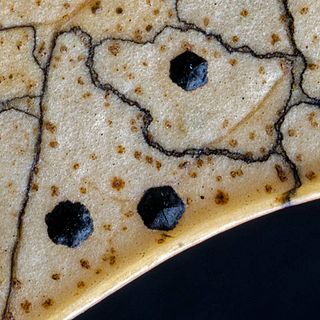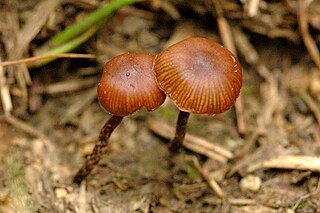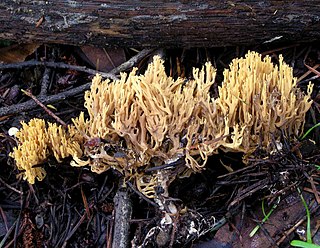
Fistulina is a genus of fungi in the family Fistulinaceae. Species in the genus cause a brown rot of both dead and living hardwood trees.

Entoloma is a genus of fungi in the order Agaricales. Called pinkgills in English, basidiocarps are typically agaricoid, though a minority are gasteroid. All have salmon-pink basidiospores which colour the gills at maturity and are angular (polyhedral) under a microscope. The genus is large, with almost 2000 species worldwide. Most species are saprotrophic, but some are ectomycorrhizal, and a few are parasitic on other fungi. The type, Entoloma sinuatum, is one of several Entoloma species that are poisonous, typically causing mild to severe gastrointestinal illness.

The genus Phallus, commonly known as stinkhorns, is a group of basidiomycetes which produce a phallic, often foul-scented mushroom, from which their name is derived. The genus has a widespread distribution and, according to a 2008 estimate, contains 18 species. They belong to the family Phallaceae in the order Phallales. The best known species is the common stinkhorn.

Oxyporus is a genus of polypore fungi in the family Schizoporaceae. An individual family Oxyporaceae was described for the genus. A number of species in this genus are plant pathogens, causing a white rot. The genus is widely distributed.

Hymenochaete is a genus of fungi in the family Hymenochaetaceae. The genus has a widespread distribution, especially in tropical regions.

Phylloporia is a genus of polypore fungi in the family Hymenochaetaceae. A 2012 estimate placed 23 species in the genus; this number was increased to 30 by 2015.

Antrodia is a genus of fungi in the family Fomitopsidaceae. Antrodia species have fruit bodies that typically resupinate, with the hymenium exposed to the outside; the edges may be turned so as to form narrow brackets. Most species are found in temperate and boreal forests, and cause brown rot.

Mycoacia is a genus of toothed crust fungi in the family Meruliaceae. It was circumscribed by Dutch mycologist Marinus Anton Donk in 1931.

Pseudoplectania is a genus of fungi in the family Sarcosomataceae. The genus contains 12 species. Pseudoplectania ryvardenii was described in 2012, while Pseudoplectania carranzae was transferred to the genus in 2013.

Coccomyces is a genus of fungi in the family Rhytismataceae.

Pisolithus is a genus of fungi within the family Sclerodermataceae.
Clarkeinda is a genus of fungi in the family Agaricaceae. According to the Dictionary of the Fungi, the widespread genus contains five species. Species in this genus, especially Clarkeinda trachodes, are only distributed in south Asia and southeast Asia.

Otidea is a genus of fungi in the family Pyronemataceae. The genus is widely distributed in northern temperate regions.

Lyophyllum is a genus of about 40 species of fungi, widespread in north temperate regions.

Deconica is a genus of mushroom-forming fungi in the family Strophariaceae. It was formerly considered synonymous with Psilocybe until molecular studies showed that genus to be polyphyletic, made of two major clades: one containing bluing, hallucinogenic species, the other non-bluing and non-hallucinogenic species. Deconica contains species formerly classified in the sections Deconica and Coprophila of Psilocybe.
Tropicoporus tropicalis is a mushroom of the family Hymenochaetaceae. Tropicoporus tropicalis is a wood-decaying basidiomycetes that rarely causes disease in animals and human, and is commonly found in humid climate such as Brazil. In its natural environment, the fungus is associated with white rot woody angiosperms, and has its annual fruiting body on tree trunks and branches. Tropicoporus tropicalis has two kinds of hyphae, generative and skeletal, that lack clamp connections.
Inonotus rigidus is a species of fungus in the family Hymenochaetaceae. It is distinguished by its resupinate and rigid basidiocarps, its yellow pore surface, being microscopically ellipsoid and yellowish brown, its thick-walled basidiospores, and by lacking both setal hyphae and hymenial setae.

Inocutis is a genus of nine species of polypore fungi in the family Hymenochaetaceae.

Ramaria myceliosa is a species of coral fungus in the family Gomphaceae. Found in North America, it was originally described by Charles Horton Peck in 1904 with the name Clavaria myceliosa. The type was collected by botanist Edwin Bingham Copeland in the mountains near Stanford University in California. E.J.H. Corner transferred it to the genus Ramaria in 1950. Giachini and colleagues proposed that Ramaria myceliosa is the same species as the European Phaeoclavulina curta, but did not provide molecular evidence to support their suggested synonymy. In a recent (2014) publication on California fungi, the authors propose the transfer of Ramaria myceliosa to the genus Phaeoclavulina, but as of January 2016, this transfer has not been accepted by either MycoBank or Index Fungorum.
















